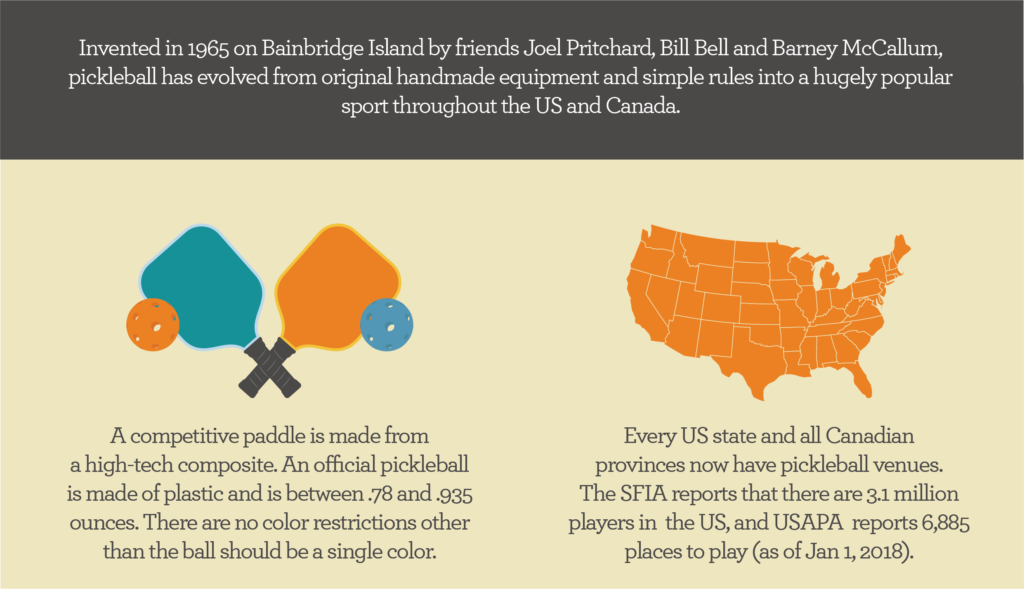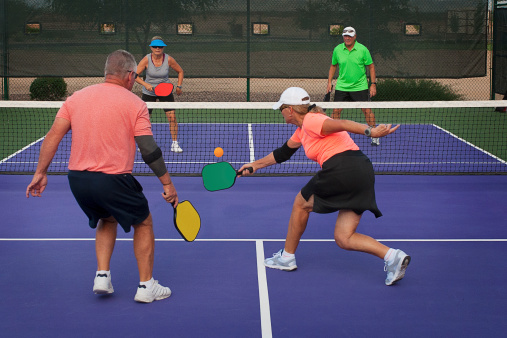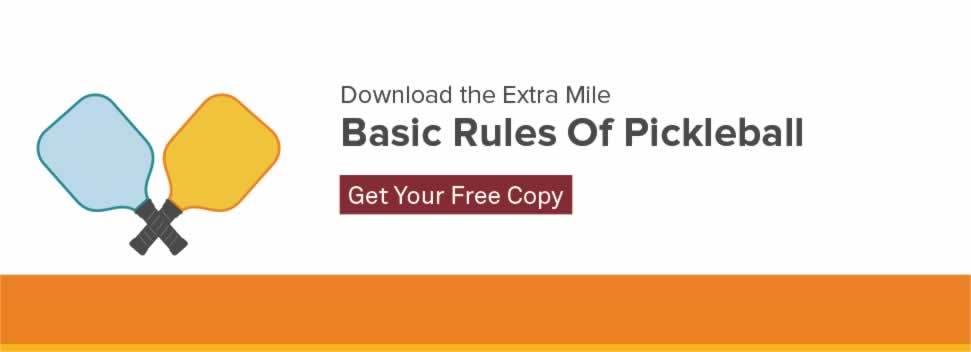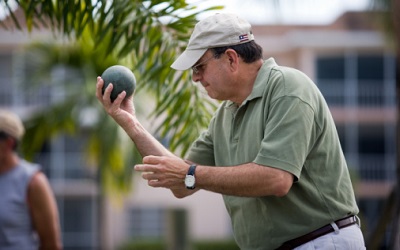The Pickleball-playing community is seeing a growing number of players on its courts. Pickleball is a sport that combines tennis, badminton and ping-pong. It’s played by two to four players using paddles and a plastic ball with holes. The court can be either indoors or outdoors and is about one-third the size of a standard tennis court.
The game has become particularly popular among people in their 50s, 60s and 70s looking for an activity that offers good aerobic exercise without being as strenuous as traditional racket sports. An important bonus: it gives players the chance to socialize during the game.
“It’s the right mix of exercise and fun competition with friends for a person my age,” said Armand Nadeau. Nadeau plays the sport several times a week at a local pickleball center.
How Pickleball Began
The game was first invented in 1965 on Bainbridge Island, Washington near Seattle at the home of former U.S. Congressman Joel Pritchard—who was then a state representative. He and two other dads returned from golfing to find their families bored. No one could find the shuttlecock for the badminton, so they used wiffle balls instead, lowered the badminton net and used ping-pong paddles to invent their own game. Thus, Pickleball was born.
The origin of the name has been debated. Some people have claimed the odd name for the sport was derived from the “pickle boat,” a nickname for the last boat to return from a fishing trip. This boat would carry the leftover oarsman and gear, similar to how pickleball began by using leftover equipment from other sports. However, a family friend has said the Pritchards had a cocker spaniel named Pickles who would chase after the balls while they were playing the game, so they named the game after him.
No matter where the name came from, pickleball soon became extremely popular among Pritchard’s neighbors, eventually spreading from Bainbridge Island to become a worldwide sport.
Click the image to open the PDF version of pickleball history.

Pickleball Tournaments | A Growing Success
The first known pickleball tournament was held in 1976, according to the USA Pickleball Association. USAPA was organized in 1984, and the first official rulebook was published that same year. By 1990, pickleball was being played in all 50 states. The sport continued to spread as it became increasingly popular in athletic events for older individuals in the early 2000s. Though the sport is now more than 50 years old, it’s grown rapidly over the past decade. The USAPA estimates that about 3.46 million people now play the game nationwide and there are nearly 6,900 known places to play, up from fewer than 50 places in 2003.
The association hosts tournaments around the country, allowing more people to learn about and watch the sport.
Why Is Pickleball so Popular?
Move over, golf and tennis. Pickleball is now a favorite pastime in America.
A big reason for the popularity of the game among adults is that it helps them stay physically active, albeit on a smaller court, with a slightly lower net and larger, slower-paced balls relative to tennis. This means it can be enjoyed by people who may not be able to play tennis, but enjoy similar games.
For players of any age, pickleball offers the mental and physical challenge and hand-eye coordination required by a game like ping-pong while providing more physical activity—often outdoors. At the same time, it’s generally easier to learn how to play pickleball than more-intense racquet sports like tennis, which can take months of practice to play well. By comparison, pickleball is generally faster to learn.
It’s also a great way to be social while staying fit. In fact, many retirement communities across the U.S.—particularly in southern states such as Florida and Arizona—have built on-site pickleball courts in recent years. They’ve also designated the sport as one of the main social activities they promote among their residents.
Pickleball Is Easy to Learn
“This is an easy sport to learn,” Jay Schofield, a retired high school physical education teacher who lives on Martha’s Vineyard, told the island’s paper. “You can develop some proficiency pretty quickly. I’ll get someone who’s never played, and they will be playing competitively within a couple of sessions.”
Another allure: Many pickleball players can teach their grandchildren to play with them.
Though it’s especially popular in southern states where it can be played outdoors year-round, it’s popular in northern states as well. Some local athletic centers, such as YMCAs, now host leagues and mark pickleball lines on tennis courts so they can be used for both sports.
The game has gotten so popular in some areas that lines can form outside pickleball courts, causing many enthusiasts to urge their communities to add more courts.
Rules of the Game
Pickleball can be played as either a singles or doubles game. For both singles and doubles, the size of the court is 20×44 feet, the same as a double badminton court.

Rules of the game include:
- The serve must be underhand and below the waist. It must be made at least one foot behind the baseline, struck diagonally.
- The serve must land within the opposite diagonal court.
- Only the team serving the ball is able to score points, which take place when the opposite side fails to return the ball or commits other faults, such as hitting the ball out of bounds.
- When the ball is served, the receiving team must let the ball bounce once before hitting it back, as must the serving team when returning it.
- Once the ball has bounced once in each team’s court, it is permitted to volley the ball (i.e., hit it before it bounces).
- Games normally go to 11 points with the leading team needing to be 2 points ahead to win.
Click the image to open the PDF version of basic pickleball rules.

The sport also has rules specific to players in wheelchairs. Though many of the rules are similar to the standard rules, there are some basic differences, including getting up to two bounces of the ball on their side of the net instead of one. Also, the wheelchair can move once while the player is serving the ball.
How to Start Playing
Thanks to the fast-growing popularity of the game, it’s easier than ever to start playing and to find other players in your area.
USAPA’s website has many helpful resources, including a map of places to play and contacts for “ambassadors” of the sport and local pickleball clubs. They can connect you with others in your area who are already playing and may be willing to teach you.
Pickleball Equipment: What Is Needed to Play?
Beyond having access to a pickleball court (or a tennis court with pickleball line markings), you also need some basic equipment to start playing. Here are the main essentials:
1. Paddle
A pickleball paddle is between the size of a tennis racket and a ping-pong paddle. You generally have a choice among several different types of core materials, including fiberglass (often called composite), graphite, aluminum and wood. The material of the paddle can affect its price, but also its performance.
- Aluminum is lightweight and provides a high level of control, but it may lack the power provided by a heavier paddle made of fiberglass.
- Wood paddles are often the cheapest, but they are also the heaviest, making them somewhat harder to control.
A beginner may want to choose a lighter-weight paddle with an oversized head as it will provide more control and increase the odds of hitting the ball. A more experienced player, on the other hand, may be willing to choose a heavier paddle but one with more power. Ultimately, however, you should choose the paddle that feels most comfortable for you. It’s worth trying out at least a few options before settling on one.
2. Pickleball
Pickleballs have holes like wiffle balls and come in two basic designs for either indoor or outdoor use. The balls with larger holes are typically for indoor use, since wind is less of a concern. They come in a large variety of colors, but yellow is the most popular color for outdoor balls because it stands out nicely against blue or green courts. Indoor pickleballs come in a wide range of colors. The International Federation of Pickleball requires that pickleballs not be more than one color.
3. Net
The court you use may already have a pickleball net of the right size and length, but if not, you can buy a USAPA Portable Net System that’s easy to carry and set up.
Pickleball Apparel and Accessories: What Do You Wear to Play?
Beyond the equipment, you may also want to buy some apparel and accessories that will make playing the game more comfortable. Pickleball apparel and accessories worth considering include:
1. Comfortable Sportswear
You’ll want to wear clothes that give you a good range of motion while keeping you cool even if you work up a sweat. You may choose shorts or sweatpants and short- or long-sleeved shirts. Many clothes designed specifically for tennis and pickleball include wicking fabric that draw moisture away from the body.
2. Tennis Shoes
Running shoes and cross-training sneakers won’t cut it. Running shoes have ridged soles that help propel you forward but can cause slipping when you’re using them for other types of motions. Cross-training sneakers have grooves on the bottom that can stick to the court’s acrylic surface and also cause you to trip. Therefore, tennis sneakers will generally be the safest and most comfortable choice. They generally have rubber soles that provide cushioning for the hardcourt surface but also have tough materials in the right places to support your feet and ankles during sudden starts and stops. In fact, you should look for tennis shoes that have a toe guard, extra padding and special cushioning for stop-and-go movements. According to PickleballAce’s website, some of the best pickleball shoes include:
- The ASICS Women’s Gel Rocket 7
- K-Swiss Women’s Hypercourt 50TH-W
- ASICS Women’s Gel-Dedicate 4
- ASICS Men’s Gel Dedicate 5
- Adidas Men’s Barricade Club
- ASICS Men’s Gel Rocket 7
3. Carrying Bag
Though not a requirement, a pickleball carrying case will make it easier to carry your paddle, balls and any other gear or personal items (such as keys and a towel) you choose to bring along. Look for a bag that fits the amount and type of equipment you’re bringing, as some can hold multiple paddles and balls. Also consider getting one that includes a cooler that can hold your water bottles or other refreshments.
4. Sunglasses
If you play outdoors, having a pair of shatter-proof sunglasses designed for athletic wear will prevent the sun’s glare from interfering with your game while also protecting your eyes.
The USAPA offers the official USA Pickleball Association Store, which has a complete line of pickleball clothing along with other merchandise emblazoned with the official association logo.
Pickleball Terms You Need to Know
Like most sports, pickleball has special terminology that its players use to describe various shots and situations. Some of the terms overlap those used in tennis and other racquet sports, but others are unique. You will surely begin to learn these terms as you start playing, but it’s helpful to know some key phrases beforehand, like:
Groundstroke: When a player hits the ball after it bounces once. There are two basic kinds including:
- Forehand groundstrokes
- Backhand groundstrokes
Dink: A shot that clears the net and lands within the “non-volley” zone on your opponent’s side.
Lob: A shot that moves in a deep, high arc over the net and often forces the opponent to back up to the baseline.
Dead ball: The ball is out of bounds and the current point is over.
Fault: A violation of a rule that stops the play.
Side out: When the person or team serving the ball loses the point. A “side out” is declared and the opponent begins to serve.
No Better Time to Start Playing
There’s no time like the present to get started. Pickleball combines exercise and an opportunity to socialize and have fun—like Extra Mile reader, Anita, commented below, “If in doubt…try it out!”
If you enjoyed this article, you seem like the type of person who enjoys living your best life. We support you and want to help you do just that. Check out these handpicked articles for you:
- Seven Habits of People Who Enjoy Long Lives
- Benefits of Volunteering and How to Find the Right Opportunity
- Hobbies for the Young at Heart
Have you played Pickleball? What did you think? What other sport or hobby keeps you active? Let us know in the comments section below.






Whenever we travel around the country and look for pickleball courts, this site comes in handy: https://quickpickle.com. It shows you all the available courts in the state and I believe it has over 12,000 locations. Might help! 🙂
I found this article very informative about “Everything You Need to Know About Pickleball”. Looking forward for more informative articles.
Sounds like a good fun game to play especially if you have arthritis. Anything to play and compete with the grandkids is great and a chance to beat them is fantastic. I’ll be looking for equipment next time we’re out shopping.
I having been playing for several years. Love the game. You all have done a good job with the above information about the game.
Great description! With a little work, you can make this more inclusive by eliminating only male pronouns (“he” is used throughout) – eliminate the use of pronouns and choose “player” or similar description. Thank you for your consideration.
Christie (who is tired of only male pronouns, I gotta say! LOL)
I am 72 years old and had stopped playing tennis 3 years ago due to bad knee and with vertigo. Serving and running is no fun anymore. Due to Covid shutdown my friend introduced me to pickleball. I love the game because serving underhand is easier compared to tennis overhead serve, and with vertigo is a big problem. Now everything is fun because I can compete with younger players and sometimes winning (ha ha ha).
This article is interesting I think I am going to gear up and find where to play.
Can’t wait to start!
I have heard and read plenty about Pickle Ball. Sounds like great fun and decent exercise.
Good reading
so funny, my aunt & uncle used to play Pickleball back in the early ’60’s. I would love to start
playing if anyone knows of a group.
thanks
go online usapa and choose “places2play” and enter your location. That’s the quickest route!
Awesome article about Pickleball! My wife and I have been playing Pickleball for over eight years and absolutely love it. We both turn 70 this year and Pickleball keeps us active both physically and socially! Living in Florida during the winter months gives us the opportunity to play almost every day and sometimes twice a day.
another online age related article but rare because it’s aimed to us oldsters!…I look forward to these specialized contributions from your Extra Mile dept. Thanks Roger (age 74) Portland Or.
Lots of my friends play Pickle ball and love it, including my daughter who plays both tennis and PB well. I also have played it but am still, at 84, more into both singles and doubles in tennis. Bend, Oregon has become somewhat of a PB haven, with 16 excellent outdoor courts and a very nice indoor facility with 8 PB courts. They did it the right way by putting PB courts in one place far from the tennis courts and avoiding the rancor found in many RV/retirement parks when PB players expect the tennis players to give them all they want in the way of courts, now! One thing not mentioned is the loudness occurring when the ball is hit, which is a big complaint of tennis players when the courts are nearby each other. However, both will survive and continue to add to our living the best way we can as we age.
Fun sport, made some great friends..
still like tennis best
I need to learn how to play, but it sounds really fun. Age 57. Thanks
I would like to update our older neighborhood tennis court that is not being used to a new pickle court. Here in Decatur IL.
I am very interested in learning to play pickleball at the Glades next Winter!
If in doubt…try it out!
I had back surgery 1 1/2 years ago…I am so much stronger and way more flexible.
Better alternative to tennis.
Made a ton of new friends in just 3 months.
Doesn’t take very long to get the hang of it.
Enjoy!!
Thanks for sharing your experience, Anita!
Pickleball is great for us seniors because it requires a lot less fitness compared to tennis and is easier on the joints. My wife and I just started playing in our local community and love it. Seemed a bit odd at first and I had dismissed it for years, but we read through some simplified rules and guides over on https://www.picklesball.com and have not looked back.
One thing I would add to the article is that it is really a very social sport and a great way for us seniors to make new friends as well as stay active.
I really had got to a low point being 74 and not able to play tennis anymore but Pickleball has really made a difference to our lives. I wish I had started playing 20 years ago!
We are glad you love pickleball John! Thanks for sharing your experience.